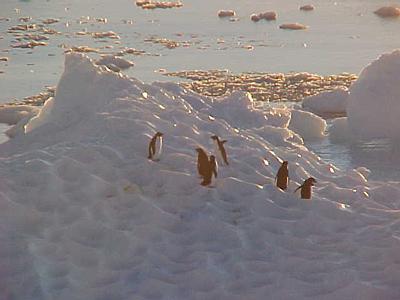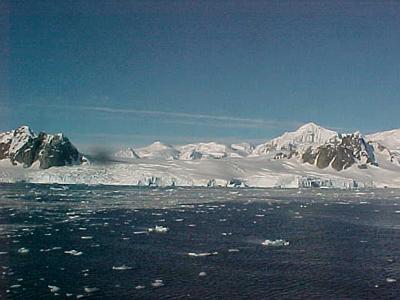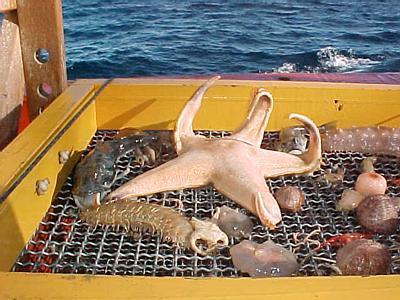16 March, 2000
Another sunny, beautiful day at Station A, latitude 64..12 S and
Longitude 65.22 W. We finish collecting our core samples with the
box core,Kasten core and megacore. This is a very abundant site.
We can see lots of worms as we wash the sediments from the cores.
Our huge plankton samples from the Tucker Trawl confirm this. Our
Otter Trawl is teeming with invertebrates: polychaetes and
nemertieans (worms), asteroids (sea stars), holothuriaans, peniagone,
urchins, anemones, scotoplanes (sea pigs), pictagonids (sea spiders),
sponges, crinoids, shrimp, bivalves, and gastropods (snails). There
are also a few fish, some of them ice fish which do not need red
blood cells. The oxygen is so rich in the deep cold water, the blood
is able to absorb enough from the gills without the aid of red blood
cells.
In the afternoon the decision is made to travel to the French Passage
and Penola Strait to gather some sea ice. New research will be
started on the bacteria which inhabits sea ice. This is a beautiful
area of Antarctica; snow covered mountains on both sides of the
passages with glaciers flowing down into the sea. Little icebergs
are floating everywhere. The ship gently pushes them aside to
continue on course. As we travel through the ice we see leopard
seals and penguins resting on the larger chunks. A Minke whales blow
and sound repeatedly among the ice. A small group leaves the ship on
a Zodiac to search for sea ice leaving the rest of us time to revel
in the beauty surrounding us as we drift gently in the water.
The search for sea ice is unsuccessful. The ice surrounding us has
all been calved from glaciers not frozen from sea water in the
subzero winter temperatures. However, the afternoon cannot be
considered a loss with all of the beauty around us to absorb. The
evening ends with a sunset beyond the icebergs and a brilliant
moonrise over the peaks. We steam back to our research sites to
complete the last of our sampling.

Penguins on an ice berg

A Minke whale in the ice.

A glacier flows into the water of the French Passage

The animals from the Otter Trawl at Station A are huge
Contact the TEA in the field at
.
If you cannot connect through your browser, copy the
TEA's e-mail address in the "To:" line of
your favorite e-mail package.
|
